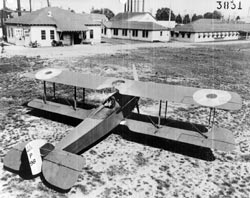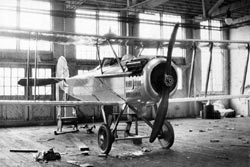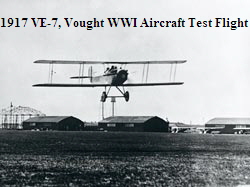|
 In May 1918, the Signal Corps ordered a paltry 14 VE-7’s from Vought. It was the policy in those days, when a company submitted a winning design, that the government purchased the plans and rights to build the aircraft as they chose. Consequently, while Vought was building its VE-7’s, the Aircraft Division at McCook Field was able to build two of their own. It was also policy to place quantity production contracts with companies other than those who developed winning designs (low bidders). In late October 1918, Gen. William L. Kenly, Chief of the newly formed Department of Military Aeronautics of the Army, placed an order for 1,000 VE-7’s with two other companies. In May 1918, the Signal Corps ordered a paltry 14 VE-7’s from Vought. It was the policy in those days, when a company submitted a winning design, that the government purchased the plans and rights to build the aircraft as they chose. Consequently, while Vought was building its VE-7’s, the Aircraft Division at McCook Field was able to build two of their own. It was also policy to place quantity production contracts with companies other than those who developed winning designs (low bidders). In late October 1918, Gen. William L. Kenly, Chief of the newly formed Department of Military Aeronautics of the Army, placed an order for 1,000 VE-7’s with two other companies. The Springfield Aircraft Corporation, Springfield Massachusetts, which like the Lewis & Vought Corporation had been organized only the previous year, received a contract for 500. The order for the remaining 500 was placed with the Sturtevant Aeroplane Company, Jamaica Plains, Massachusetts. Four days later, Gen. Kenly recommended that the order be increased to 3,000. The Springfield Aircraft Corporation, Springfield Massachusetts, which like the Lewis & Vought Corporation had been organized only the previous year, received a contract for 500. The order for the remaining 500 was placed with the Sturtevant Aeroplane Company, Jamaica Plains, Massachusetts. Four days later, Gen. Kenly recommended that the order be increased to 3,000.
Contract Cancellation - A Familiar Experience
Two weeks later, the war was over. The Armistice had been signed, and both of these contracts were canceled. Of the fourteen purchased in May from Lewis & Vought, five or six were delivered before the end of the war. Four Springfield VE-7’s were delivered, and the two at McCook Field were completed. The VE-7 was not in production earlier because of an interim program which had all the available Hispano engines diverted to upgrade the Curtiss Jenny from the 90-hp JN-4D to the 150-hp JN-4H.
While the massive contract cancellations caused many companies to go under, Vought was fortunate; the Army contract remained in force and deliveries continued. The new company’s first big payday came on July 19, 1918, when it received a $100,000 check from the Army Signal Corps in payment for VE-7 deliveries.
Vought’s total wartime output is not known, but it did not stop with the November 11, 1918 Armistice.
In 1919, as the crated VE-7’s were arriving at McCook Field, Vought demonstrated his deep personal interest in every facet of his planes; he hung around the crew of Master Sergeant Jack Harding, supervising the work of putting each ship together. Harding stated that it was foolish to argue a point with Chance because he knew a lot more about airplanes than any of them. “The VE-7 was the sweetest ship I was ever in,” was his personal evaluation. As impressed with the man as he was the machine, Harding continued, “Vought was the most natty dresser I ever saw – always wore spats and carried a cane, was a man of outstanding personality, and he seemed to have been able to bring out some of his personality in his airplanes. He never came to McCook Field without his airplane finished in every respect.” about airplanes than any of them. “The VE-7 was the sweetest ship I was ever in,” was his personal evaluation. As impressed with the man as he was the machine, Harding continued, “Vought was the most natty dresser I ever saw – always wore spats and carried a cane, was a man of outstanding personality, and he seemed to have been able to bring out some of his personality in his airplanes. He never came to McCook Field without his airplane finished in every respect.”
More about the VE-7:
The Aircraft That Got a Company off the Ground
VE-7 Production
Additional VE-7s
VE-7 as a History Maker
|

 In May 1918, the Signal Corps ordered a paltry 14 VE-7’s from Vought. It was the policy in those days, when a company submitted a winning design, that the government purchased the plans and rights to build the aircraft as they chose. Consequently, while Vought was building its VE-7’s, the Aircraft Division at McCook Field was able to build two of their own. It was also policy to place quantity production contracts with companies other than those who developed winning designs (low bidders). In late October 1918, Gen. William L. Kenly, Chief of the newly formed Department of Military Aeronautics of the Army, placed an order for 1,000 VE-7’s with two other companies.
In May 1918, the Signal Corps ordered a paltry 14 VE-7’s from Vought. It was the policy in those days, when a company submitted a winning design, that the government purchased the plans and rights to build the aircraft as they chose. Consequently, while Vought was building its VE-7’s, the Aircraft Division at McCook Field was able to build two of their own. It was also policy to place quantity production contracts with companies other than those who developed winning designs (low bidders). In late October 1918, Gen. William L. Kenly, Chief of the newly formed Department of Military Aeronautics of the Army, placed an order for 1,000 VE-7’s with two other companies. The Springfield Aircraft Corporation, Springfield Massachusetts, which like the Lewis & Vought Corporation had been organized only the previous year, received a contract for 500. The order for the remaining 500 was placed with the Sturtevant Aeroplane Company, Jamaica Plains, Massachusetts. Four days later, Gen. Kenly recommended that the order be increased to 3,000.
The Springfield Aircraft Corporation, Springfield Massachusetts, which like the Lewis & Vought Corporation had been organized only the previous year, received a contract for 500. The order for the remaining 500 was placed with the Sturtevant Aeroplane Company, Jamaica Plains, Massachusetts. Four days later, Gen. Kenly recommended that the order be increased to 3,000.
 about airplanes than any of them. “The VE-7 was the sweetest ship I was ever in,” was his personal evaluation. As impressed with the man as he was the machine, Harding continued, “Vought was the most natty dresser I ever saw – always wore spats and carried a cane, was a man of outstanding personality, and he seemed to have been able to bring out some of his personality in his airplanes. He never came to McCook Field without his airplane finished in every respect.”
about airplanes than any of them. “The VE-7 was the sweetest ship I was ever in,” was his personal evaluation. As impressed with the man as he was the machine, Harding continued, “Vought was the most natty dresser I ever saw – always wore spats and carried a cane, was a man of outstanding personality, and he seemed to have been able to bring out some of his personality in his airplanes. He never came to McCook Field without his airplane finished in every respect.”